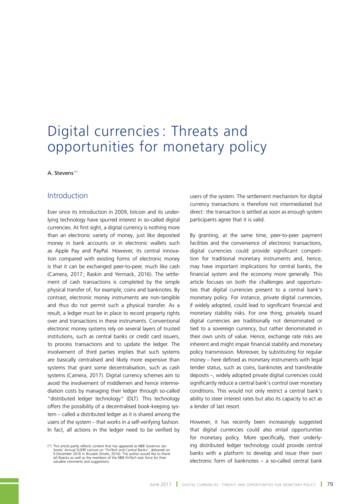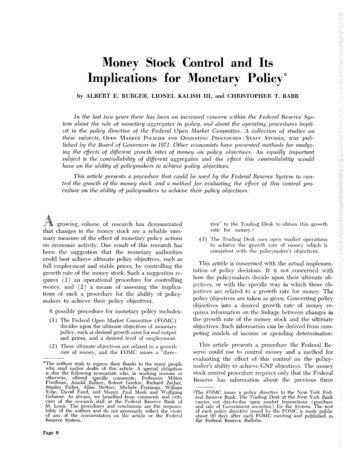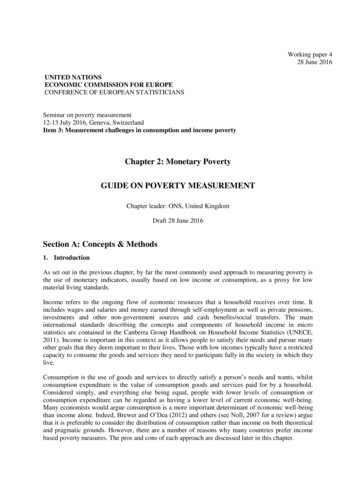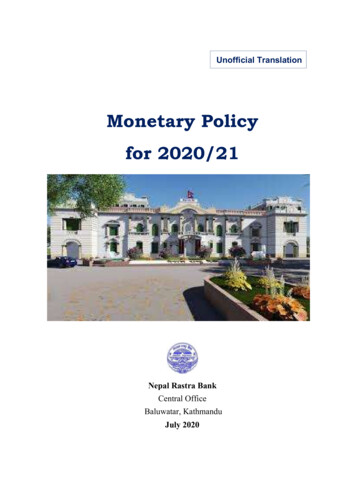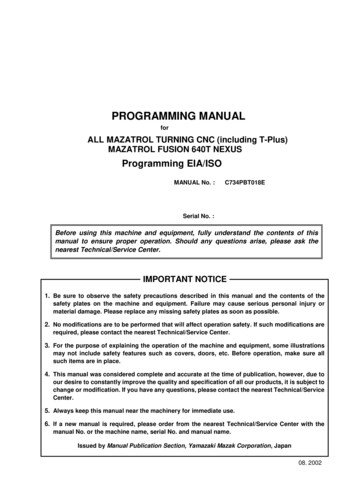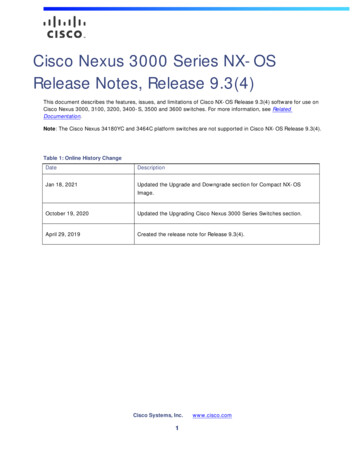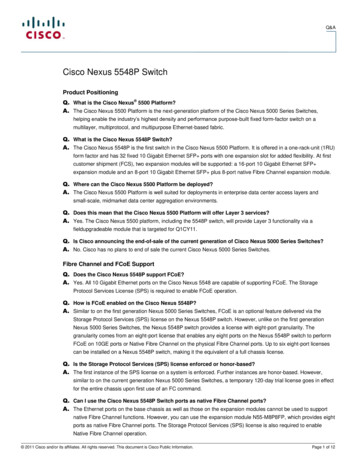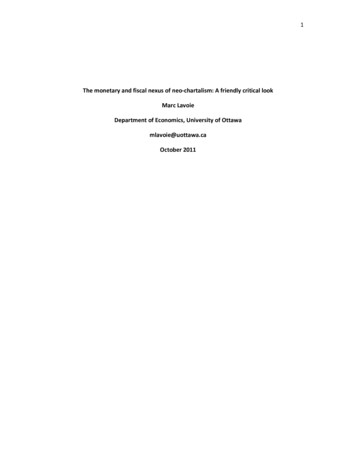
Transcription
1The monetary and fiscal nexus of neo-chartalism: A friendly critical lookMarc LavoieDepartment of Economics, University of Ottawamlavoie@uottawa.caOctober 2011
2The monetary and fiscal nexus of neo-chartalism: A friendly critical look1The global financial crisis has exposed the weaknesses of mainstream economics and it hasgiven a boost to heterodox theories, in particular Keynesian theories. The mainstream viewabout the irrelevance of fiscal activism has been strongly criticized and questioned by the activeuse of fiscal policy in the midst to the global financial crisis, although this was followed by aquick turnabout of the representative economist as soon as a deeper-than-expected recessionprovoked large government deficits and rising sovereign debt ratios. The crisis and thegeneralization of social media, most notably the multiplication of blogs on hyperspace, hasprovided more room to enthusiastic exponents of alternative economic theories. This is the casein particular of neo-chartalism, often called modern monetary theory, or MMT, on numerousblogs.The development of a strong neo-chartalist identity, by economists who were formerlyassociated with post-Keynesian economics, has led some observers to wonder about the linksbetween neo-chartalism and post-Keynesian economics. Heterodox economists, not to speak ofmainstream economists, have also found some of the claims of neo-chartalism hard to swallow.The purpose of this paper is to deal with these two issues, most of the analysis however beingfocused around the questions related to the clearing and settlement system and its relationshipwith the activities of the central government.2 In other words, neo-chartalists have put forwardpropositions that go beyond the strict limits of monetary policy, such as propositions to solvethe unemployment problem while safeguarding price stability, but these other propositions willnot be discussed here.The outline of the paper is thus the following. In the next section, I make a briefintroduction to neo-chartalism, and I discuss its relationship with post-Keynesian economics. Inthe second section, I discuss what I believe to be some of the more controversial statements ofneo-chartalism, in relation essentially to the clearing and settlement system. In the third section,I show how some of these views have been modified over time. In the fourth section, I discussthe eurozone setup in light of neo-chartalism. I conclude by claiming that neo-chartalism is trulypart of post-Keynesian economics.Neo-chartalism and its links with post-KeynesianismTo their credit, proponents of neo-chartalism have managed to have a substantial impact on theblogosphere, with several non-academic bloggers (such as Naked Capitalism) now endorsingfully and enthusiastically the ideas and claims of academic neo-chartalists, thus succeeding in1This paper was first presented at the Third International School on Keynesian Macroeconomics that washeld in Berlin, July 31-August 6, 2011. I wish to thank for their comments Gary Dymski, Eckhard Hein,Keith Newman, Tom Palley, Ramanan, Louis-Philippe Rochon and Mario Seccareccia, without implicatingthem for the statements made here.2In a sense, this paper is an extension of the few pages that I devoted to modern monetary theory in myrecent survey of post-Keynesian monetary economics (Lavoie 2011), which also arose from a presentationat a previous Berlin Keynesian summer school.
3the task of taking on board several non-academic scribblers, despite monetary matters being arather arcane subject, a result that had evaded post-Keynesians so far. Even Paul Krugman, onhis blog, has made occasional references and comments about MMT. This has been theconsequence of unrelenting efforts to be highly active on blogs by a few individuals, in particularBill Mitchell, Warren Mosler, as well as Randy Wray and his colleagues at the University ofMissouri in Kansas City (UMKC).3But who are those neo-chartalist authors and why the reference to chartalism? All postKeynesians would reject the idea that money got introduced into the economy as a way toimprove upon barter. Neo-chartalists, or modern chartalists, argue, following Adam Smith,Georg Friedrich Knapp and John Maynard Keynes, that the State determines what can serve asmoney, and it enforces this decision by its power to tax people and to require payment in thecurrency of its choice. Thus what we have here is a state theory of money, or more precisely ataxes-drive-money theory (Wray 1998, p. 18). This theory is called chartalism because thedefinition of money is proclaimed by the State, and the ability of banks to produce money isgranted by charters. We will say no more on the origins, and leave this controversial issue tospecialists and historians.Who are the modern chartalists – the neo-chartalists? The head office of the group maybe said to be at UMKC, with authors such as Randall Wray, Mat Forstater and Stephanie BellKelton, as well as former students of UMKC such as Pavlina Tcherneva, Éric Tymoigne and Felipede Rezende. Another important location is the Center of Full Employment and Equity (CofFEE)located at the University of Newcastle in Australia, with its prolific director Bill Mitchell, andacolytes such as Martin Watts and James Juniper. There are also important figures, which wemay consider as fellow travellers, such as Jan Kregel, Edward Nell and Scott Fullwiler, with thelatter intervening quite often on blogs despite having none of his own. Besides the obviousauthors who have inspired modern chartalists, Smith, Knapp and Keynes, it may be said that theoriginators of modern monetary theory are Warren Mosler, Hyman Minsky, Abba Lerner andWynne Godley, as their writings are often invoked by neo-chartalists. Despite being written by anon-academic, Mosler’s (1994) paper plays a crucial role in the story being told here, becauseMosler was certainly the first to put so much emphasis on the analysis of the clearing andsettlement system, providing support to the post-Keynesian view of endogenous money in sodoing. Finally, as written by Wray in a draft of his new book, “Others—some of whom wereinitially critical of certain aspects of the approach—have also contributed to development of thetheory: Charles Goodhart, Marc Lavoie, Mario Seccareccia, Michael Hudson, Alain Parguez, Rob3See Bill Mitchell, or his Billy Blog : http://bilbo.economicoutlook.net/blog/ ; Warren Mosler and hisCenter of the Universe: http://moslereconomics.com/ ; the UMKC academic staff and their New EconomicPerspectives blog: http://neweconomicperspectives.blogspot.com/ . Several students or former studentsat UMKC are also participating in this effort at influencing the blogosphere. Randy Wray is even writing aModern Money Primer (MMP) on line, delivering a chapter a week and asking his readers to comment soas to improve the book, in an attempt to explain MMT in simple p/modern-money-primer.html.
4Parenteau, Marshall Auerback, and Jamie Galbraith” (Wray 2011A). It should thus be obvious,since I am being identified with the development of some aspects of modern monetary theory,that I have much sympathy with modern monetary theory, although, as pointed out by Wray, Imight have reservations on some aspects.What are the main concerns or features of modern monetary theory as presented byneo-chartalist authors? We may say that they are four main topics. The first topic, alreadyalluded to, is the question of the origins of money and the claim that money is a creature of theState. A second major topic is the proposition that the State ought to act as an employer of lastresort (ELR), providing employment to anyone willing to work but unable to find work in theprivate sector. This issue is also related to the question of how to achieve full or very highemployment without generating inflation, as neo-chartalists argue that the public sector canprovide a buffer of employable workers when the private sector decides to hire more workers.There is thus an important distinction to be made between standard expansionary Keynesianfiscal policies and employment of last resort policies which would be more geographicallylocated to the areas with low economic activity. A third topic is fiscal policy. Neo-chartalists wishto reassert the importance of fiscal policy relative to monetary policy, in contrast to theneglected role that it plays in mainstream macroeconomics. As part of this, they haveresurrected the role of functional finance, in contrast to sound finance, very much putting forththe work of Abba Lerner (1943). They also make an extensive use of the three-balance identityput forward most notably by Wynne Godley (1999A) and the New Cambridge school, in anattempt to show that the domestic private sector can only accumulate financial assets if thedomestic public sector accepts to go into debt (or if the country has a positive current accountbalance, in an open economy), thus showing that public debt is not necessarily an evil. Apossible fifth topic of neo-chartalism, because of its links with the work of Hyman Minsky, couldbe the issue of financial instability, as well as its causes and remedies.While all these themes are certainly worth investigating, the focus of the present paperwill be on the fourth broad topic addressed by neo-chartalists – the study of the mechanics ofthe clearing and settlement system.4 These mechanics are examined in light of the relationshipbetween the transactions of the government sector and the monetary system, and thusnaturally there is also a link with the legitimacy of functional finance. Tied to the mechanisms ofthe payment system, and how the government is integrated into it, is the question of thedefinition of a sovereign currency. Neo-chartalists argue that their most controversialpropositions only apply to countries with a sovereign currency, and hence the definition of whata sovereign currency is takes some importance. Another related neo-chartalist theme is thedetermination of interest rates, in particular the target overnight interest rate, since some neo-4A topic that will need to be tackled in the future is the implication of government deficit spending overthe long run, when the economy is back to full employment, in an appropriate stock-flow consistentframework. A first effort at this can be found in Godley and Lavoie (2007A), Martin (2008), and Pucci andTinel (2010).
5chartalists argue that this rate, in nominal terms, ought to be zero (Forstater and Mosler 2005).But I won’t discuss this either.Before we tackle the neo-chartalist propositions on the clearing and settlement systemand their implications for government finance, I believe it is worth exploring the relationshipbetween post-Keynesians at large and neo-chartalists. As pointed out in the introduction, mostof the main neo-chartalist authors or fellow-travellers were well-known post-Keynesian authors,but on blogs they seem to have taken an identity of their own, sometimes even hinting thatpost-Keynesians don’t understand or even perhaps disagree with them. Furthermore, there is anelement of distrust with regards to neo-chartalism among a number of post-Keynesians, assome of them regard several neo-chartalist propositions as being overly extreme, whilesimultaneously being taken aback by the militant behaviour of some of its adherents oradvocates. We will come back to this double cause of mistrust. Even outside observers seem tobe aware of some tension existing between neo-chartalists and (other) post-Keynesians as thefollowing question, found on a blog illustrates: “There seems to still be a debate within the postKeynesian world about whether chartalism (of which I am still very sceptical) is in competitionwith or in conjunction with circuitism (of which I believe)” (Brazelton 2010).The response of Scott Fullwiler (2010), certainly one of the most articulate proponentsof MMT, was quite straightforward, but also revealing: “Where? There is no debate, at leastamong actual chartalists and actual circuitistes, that I can see, on whether bank money isendogenous/horizontal. We all agree on the monetary circuit or endogenous money. In fact,there's very little difference between the entire paradigm put forth by chartalists andcircuitistes/horizontalists like Marc Lavoie and Mario Seccareccia”. Fullwiler here denies thatthere is any major disagreement between neo-chartalists and post-Keynesians, but he is carefulto point out that those he has in mind are post-Keynesians of the horizontalist variety or elseFrench or Italian circuitists of the French-Italian school, such as Alain Parguez presumably.Without revisiting the whole post-Keynesian Horizontalist vs Structuralist debate on money, it isworth remembering that the more transparent procedures put in place by central banks overthe last two decades have vindicated the Horizontalist position (Lavoie 2005), and so have thestudies by neo-chartalists on the clearing and settlement system (Wray 2006). The uneasiness ofsome post-Keynesians to accept some of the neo-chartalist arguments may thus be attributed inpart to their unwillingness to entertain the mechanics of the clearing and settlement system andthe Horizontalist position.In response to a further question on the compatibility between neo-chartalism andpost-Keynesianism, in particular the scepticism with regards to neo-chartalism expressed bysome post-Keynesian such as Steve Keen, himself a Minskyan, Fullwiler (2010) reasserts thatthere is no significant difference between the endogenous money view of neo-chartalists andthat of Horizontalist post-Keynesians: “A number of people, Keen included used to think therewas some inconsistency between MMT/Chartalism and endogenous money. I think I'veexplained it enough to Keen that he gets that there is no inconsistency, but I'm not sure, sincemany on his site still say that sort of thing. As I said, though, horizontalists like Marc Lavoie will p
Department of Economics, University of Ottawa mlavoie@uottawa.ca October 2011 . 2 The monetary and fiscal nexus of neo-chartalism: A friendly critical look1 The global financial crisis has exposed the weaknesses of mainstream economics and it has given a boost to heterodox theories, in particular Keynesian theories. The mainstream view about the irrelevance of fiscal activism has been strongly .
